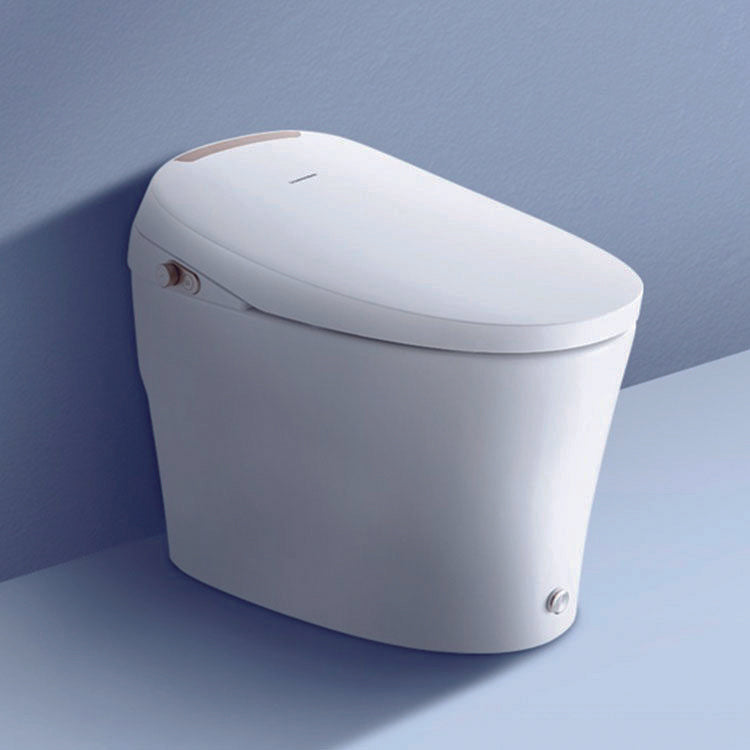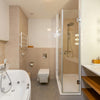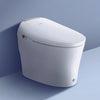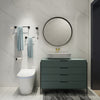How Smart Toilets are Revolutionizing Bathroom Hygiene

Introduction
The journey from rudimentary privies to sophisticated bathroom fixtures mirrors humanity's progress in sanitation and public health. Initially, toilets were little more than isolated pits in the ground; however, with the advent of indoor plumbing in the 19th century, the modern toilet began to take shape. This evolution has been pivotal not only for convenience but also for the overarching importance of hygiene in communal and private spaces.
Enter the era of smart toilets—high-tech innovations that are transforming bathroom experiences worldwide. Unlike traditional toilets, smart toilets incorporate advanced technology to enhance functionality and optimize hygiene. These devices utilize automation, user recognition, and connectivity to integrate seamlessly into the increasingly smart homes of today.
In a world where cleanliness and sanitation have never been more scrutinized, particularly in the wake of global health crises, the significance of maintaining impeccable hygiene in bathroom spaces is paramount. Smart toilets address these concerns with sophisticated features designed to minimize the spread of germs and automate cleaning processes, making them not just a luxury but a compelling necessity for health-conscious consumers. This introduction to smart toilets sets the stage for a detailed exploration of how these futuristic fixtures are setting new standards in hygiene and convenience.

Understanding Smart Toilets
A smart toilet is an advanced plumbing fixture that integrates technology to enhance the user's experience and hygiene. Unlike traditional toilets, smart toilets offer a range of features that include automated flushing, bidet washing, air drying, seat warming, and built-in deodorizers. These features not only improve comfort and convenience but also significantly elevate hygiene.
The Technology Behind Smart Toilets
The backbone of smart toilet technology is a combination of sensors and automation. Sensors in smart toilets can detect the presence of a user to automatically raise or lower the seat and initiate flushing without the need for physical contact. This touch-free technology is crucial in preventing the spread of germs and maintaining cleanliness. Additionally, many smart toilets feature bidet functions and air dryers that are automatically adjusted by sensors, which gauge the proximity and positioning of the user.
Connectivity and smart home integration represent another technological leap in the functionality of smart toilets. These toilets can connect to other smart devices via Wi-Fi or Bluetooth, allowing for remote control and customization of settings through smartphone apps. Integration with home automation systems enables users to create personalized bathroom experiences, such as pre-set preferences for seat warming and water temperature. This connectivity also facilitates maintenance alerts and software updates to keep the toilet operating optimally.
Through these advanced technologies, smart toilets not only enhance the comfort and convenience of bathroom routines but also play a critical role in promoting a hygienic environment. This integration of sensors, automation, and connectivity ensures that the smart toilet is a key player in the modern, health-conscious home.
Understanding Smart Toilets
Smart toilets represent a significant advancement in bathroom technology, combining comfort, convenience, and cleanliness with the latest in digital innovations. These high-tech fixtures go far beyond the capabilities of traditional toilets by incorporating automated features that optimize hygiene and enhance user experience.

Key Features of Smart Toilets
Smart toilets are equipped with a variety of features that set them apart from their conventional counterparts. Key features typically include:
- Automated Flushing: Systems that can detect when flushing is necessary, reducing the spread of germs by eliminating the need to touch the toilet.
- Heated Seating: Adjustable temperature settings provide added comfort, especially in colder climates.
- Bidet Washing: Integrated bidet functions with customizable water temperature and pressure settings, promoting better personal hygiene.
- Air Drying: Following the bidet, an air dryer provides additional comfort and reduces the need for toilet paper.
- Deodorizing Filters: Automatically activated filters that cleanse the air to maintain a fresh bathroom environment.
- Night Lights: Soft lighting that automatically turns on in low-light conditions, enhancing safety and convenience.
These features collectively elevate the user experience, merging traditional functionality with the benefits of modern technology. For a deeper look at smart toilet models and their features, visit our product collection page for smart toilets.
The Technology behind Smart Toilets
The integration of advanced technologies is what makes smart toilets truly innovative. These include:
Sensors and Automation
Smart toilets are equipped with numerous sensors that automate various functions such as flushing, lid opening/closing, and even seat heating. This automation plays a crucial role in enhancing hygiene as it minimizes the need to touch surfaces, thereby reducing the potential for germ transmission.
Connectivity and Smart Home Integration
Another pivotal feature of smart toilets is their ability to integrate with smart home systems. This connectivity allows for the control of toilet functions through voice commands or mobile applications, providing a seamless and highly customizable user experience. For example, users can adjust settings for flushing or the bidet's water temperature remotely, enhancing accessibility and ease of use. To learn more about how smart toilets can integrate with your home, check out our blog on smart toilet integration.
Smart toilets are not just about technological sophistication—they represent a leap towards making our bathroom experiences as hygienic, convenient, and comfortable as possible. For additional insights into how these features come together to enhance bathroom hygiene, explore our detailed smart toilet product pages.

Additional Hygiene-Enhancing Features
Smart toilets elevate bathroom hygiene through advanced features that promote cleanliness and health. These include self-cleaning capabilities, sophisticated flushing systems, and integrated air purification.
Self-Cleaning Capabilities
One of the key attributes of smart toilets is their ability to clean themselves:
- Automated Cleaning Cycles: These toilets feature automated mechanisms such as brushes or sprays that clean the bowl and seat after each use. Users can adjust these cycles based on usage, ensuring the toilet remains pristine.
- Antibacterial Materials: Constructed from materials that prevent bacterial growth, smart toilets stay cleaner and safer for every user, significantly reducing hygiene concerns.
Advanced Flushing Systems
The flushing technology in smart toilets is designed for both environmental and hygienic benefits:
- Reduced Water Usage: They use less water than traditional models, which is more eco-friendly and decreases the potential for bacteria proliferation associated with stagnant water.
- Prevention of Bacterial Growth: Efficient flushing systems ensure thorough cleaning of the bowl, aiding in the prevention of bacterial buildup.
Air Purification and Deodorization
To complement their cleaning capabilities, many smart toilets also include features to improve air quality:
- Integrated Air Purifiers: These purifiers help eliminate airborne contaminants, ensuring the air remains clean.
- Odor Elimination Technologies: Advanced technologies actively remove or neutralize odors, keeping the bathroom environment fresh and inviting.
These comprehensive features make smart toilets a superior choice for enhancing bathroom hygiene. They not only improve user comfort but also safeguard health by maintaining a cleaner and more hygienic environment. For more insights into the benefits of smart toilets, consider exploring additional resources that delve into their innovative features.
The Impact of Smart Toilets on Bathroom Hygiene
Smart toilets have marked a significant step forward in maintaining cleanliness and health standards in bathroom environments. By comparing traditional toilets with smart toilets, reviewing case studies, and considering expert and user insights, we can see a clear picture of their benefits.
Comparative Analysis: Traditional Toilets vs. Smart Toilets
Traditional toilets, while functional, often lack features that promote optimal hygiene. They require manual cleaning and contact with potentially contaminated surfaces for operation. In contrast, smart toilets offer automated features such as touch-free flushing, self-cleaning capabilities, and sterilization processes that significantly reduce the need for contact and manual labor.
- Touch-free Technology: Reduces the spread of germs as users do not need to touch the toilet for flushing or closing the lid.
- Automated Cleaning: Ensures consistent cleanliness with scheduled cleaning and sterilization cycles that traditional toilets cannot offer.
Case Studies: Reduction in Germs and Infections
Recent studies have demonstrated that smart toilets significantly minimize the presence of pathogens in bathroom environments. For example:
- Hospital Study: A study conducted in a hospital setting revealed that restrooms equipped with smart toilets had a significantly lower level of surface bacteria compared to those with traditional toilets. This was attributed to the smart toilets' automated flushing and self-cleaning capabilities, which effectively reduce the potential for bacterial spread.
- University Research: Researchers at a major university tested the impact of UV sterilization features in smart toilets and found a drastic reduction in the survival rate of common pathogens, including E. coli and staphylococcus aureus, within the toilet environment.
User Testimonials and Expert Opinions
Feedback from users who have switched to smart toilets often highlights the enhanced cleanliness and ease of use they experience, leading to a more satisfactory and hygienic bathroom environment. Health experts also advocate for smart toilets, citing their automated features and consistent cleaning cycles as vital for reducing the spread of infectious diseases.
"The seamless operation and superior hygiene features of smart toilets represent a revolution in how we view bathroom cleanliness," one health expert noted, reflecting a widespread endorsement of this technology.
The impact of smart toilets on bathroom hygiene is evident through these comparative analyses, case studies, and testimonials. By minimizing human error and maximizing hygiene automation, smart toilets provide a cleaner, healthier bathroom experience. This shift not only enhances individual comfort and safety but also sets new standards for public health practices in communal and residential settings.

Future Trends in Smart Toilet Technology
As technology evolves, so too does the landscape of home appliances, including smart toilets. The future of these advanced fixtures is likely to see further integration with artificial intelligence, enhanced health monitoring capabilities, and new challenges that will need to be addressed to maximize their potential.
Innovations on the Horizon
The next generation of smart toilets is expected to incorporate even more sophisticated technologies:
- AI Integration: Artificial intelligence can provide personalized insights into health by analyzing waste. This could lead to early detection of dietary changes, health issues such as infections, or chronic conditions like diabetes, offering a new layer of preventive healthcare from the comfort of one's home.
- Health Monitoring: Beyond routine analyses, future smart toilets may monitor physiological data such as weight, blood pressure, or even blood sugar levels through non-invasive means. This ongoing collection of health data could be integrated with digital health records, providing continuous, real-time health monitoring.
Potential Challenges and Considerations
With these advancements, several challenges arise that must be thoughtfully considered:
- Privacy: As toilets become capable of collecting detailed health data, ensuring the privacy and security of this sensitive information becomes paramount. Users will need guarantees that their data is protected against unauthorized access and breaches.
- Accessibility: Advanced technology often comes with a high price tag, which can limit accessibility. Making these beneficial technologies available to a wider audience will be crucial, as will designing interfaces that are user-friendly for all ages and abilities.
The Role of Smart Toilets in the Future of Hygiene
Smart toilets are set to play an increasingly important role in public health and personal hygiene. As they become more integrated with health monitoring and AI, they can contribute significantly to preventative health measures and hygiene management, potentially reducing healthcare costs and improving quality of life.
Their ability to provide valuable health data while ensuring a hygienic environment positions smart toilets not just as bathroom fixtures, but as integral components of home health ecosystems. As we look to the future, the continuous improvement and integration of these technologies promise to make smart toilets a standard fixture in homes, enhancing not only personal hygiene but also overall health surveillance.
Conclusion
As we have explored throughout this blog, smart toilets are fundamentally revolutionizing bathroom hygiene through advanced technology that enhances both cleanliness and user comfort. These innovative fixtures seamlessly blend convenience with functionality, offering features like automated cleaning, touch-free operations, and personalized user settings that elevate the standard bathroom experience to new heights.
Smart toilets strike an important balance between technology and comfort. They not only make bathrooms more hygienic but also add a level of comfort and luxury that was previously unavailable in traditional setups. The intuitive design and user-friendly interfaces ensure that these benefits are accessible to all, making it easier than ever to maintain high hygiene standards without compromising on comfort.
For those considering a bathroom upgrade, the choice is becoming increasingly clear. The integration of smart toilets into your home is not just about keeping up with technology trends; it’s about making a proactive choice for better hygiene, enhanced comfort, and overall well-being. We encourage you to explore the options available and consider how a smart toilet could improve your daily routine. For more details and to view available models, visit our smart toilet product collection page. To read more about how these technologies can fit into your lifestyle, check out our comprehensive guide on smart toilets.
Embracing smart toilets means stepping into a future where bathroom hygiene is guaranteed through intelligent design and advanced technology—ensuring a cleaner, healthier home environment for you and your family.
FAQs:
-
What are smart toilets and how do they work?
Smart toilets are advanced bathroom fixtures equipped with technology designed to improve cleanliness and user experience. They feature automated flushing, bidet functions, seat warming, and self-cleaning capabilities, often controlled via touch-free sensors or remote apps for enhanced hygiene and convenience. -
What hygiene benefits do smart toilets offer over traditional toilets?
Smart toilets offer significant hygiene improvements such as UV sterilization to kill bacteria and viruses, automated lids to prevent germ spread, and hands-free operation to reduce contact with potentially contaminated surfaces. These features help maintain a cleaner and more sanitary bathroom environment. -
Are smart toilets environmentally friendly?
Yes, many smart toilets are designed to be environmentally friendly. They typically use less water per flush compared to traditional toilets and some models feature eco-friendly functions like low water usage settings and energy-efficient heating elements, contributing to a more sustainable household. -
How do smart toilets integrate with smart home systems?
Smart toilets can integrate with smart home systems through Wi-Fi or Bluetooth connections, allowing them to be managed via smartphones or voice-activated devices. This integration enables users to customize settings like seat temperature and flushing preferences, and receive maintenance notifications. -
What should I consider before buying a smart toilet?
Before purchasing a smart toilet, consider factors such as compatibility with your current bathroom setup, the cost of installation, and what features are most important for your needs. Additionally, think about ongoing maintenance requirements and whether the model you choose supports updates and connectivity with your existing smart home technology.




